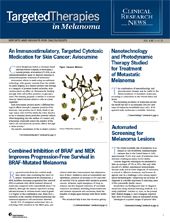An Immunostimulatory, Targeted Cytotoxic Medication for Skin Cancer: Aviscumine
Cytavis Biopharma GmbH, a Germany-based pharmaceutical company, is developing a natural protein, aviscumine (CY-503), as an immunostimulatory agent to improve response to immunotherapeutic treatment of melanoma.
Figure.Europena Mistletoe
Source: Wikimedia Commons
Cytavis Biopharma GmbH, a Germany-based pharmaceutical company, is developing a natural protein, aviscumine (CY-503), as an immunostimulatory agent to improve response to immunotherapeutic treatment of melanoma.1Aviscumine, which is made using recombinant technology with genetic material from the mistletoe plant(Figure), is a dimeric protein that belongs to a category of proteins known as lectins. Aviscumine exerts an effect on ribosomes by binding strongly with cell surface proteins, or glycoproteins. This binding property is similar to a mechanism by which bacteria attach to cells in a host organism.1
Each aviscumine protein exerts 2 different biological effects through 2 separate portions of its structure. One portion, the B chain, binds to epitope tumor cells (CD75s), while the other (known as the A-domain) exerts powerful cytotoxic effects. After integrating into the surface of a tumor cell, aviscumine eventually enters the interior of the tumor cell and exerts its cytotoxic effects through A-chain activity.1
The specific mechanism of the A-chain’s cytotoxic effect is through inhibition of ribosomal activity. By disrupting the function of ribosomes, which are important for the growth and development of any cell because of their role in protein synthesis, aviscumine induces cell apoptosis.1
Aviscumine also acts as an immunostimulant in nontumor cells, increasing levels of interleukins, activating natural killer cells, and promoting neutrophil formation. Animal model studies have proved the cytotoxic and cytostatic effects of aviscumine in solid tumors, such as a mouse model of melanoma with lung metastases.1
In an early phase I study of aviscumine in patients with solid tumors, Schöffski et al determined the safety profile, assessed dose-limiting toxicities, and researched the maximum tolerated dose for this novel biologic therapy. With a median age of 58 years, 14 patients with cancers including colorectal cancer, soft tissue sarcoma, and pancreatic cancer— received aviscumine. The most common adverse events (AEs) after the first infusion of aviscumine included fatigue, fever, nocturia, urticaria, erythema, and pruritus. Fatigue and liver toxicity were found to be dose-limiting, severe AEs.2
In another phase I study published by Bergmann et al in 2008, subcutaneous dosing of aviscumine was assessed as a treatment for 26 patients with colorectal cancer, soft tissue sarcoma, melanoma, and several other types of cancers. Patients received treatment up to a maximum dose of 10 ng/ kg, and no dose-limiting toxicities were detected. Common AEs included injection-site reactions, all of which were grade 1 to 2 in severity. Grade 3 and grade 4 AEs were absent in the study. Increases in interleukin levels and interferon levels were detected in treated individuals, although, paradoxically, interferon levels did not increase in patients treated with 6-ng/kg doses or higher.3
In a recent phase II study published in theJournal for Immunotherapy of Cancerin August 2014, investigators Trefzer and colleagues tested the safety and efficacy of aviscumine in patients with stage IV metastatic melanoma who had failed to achieve a treatment response with prior therapies.
A total of 32 patients in the single-arm, open-label trial received a twice-weekly dosage of 350 ng of aviscumine injected subcutaneously. Patients had good Eastern Cooperative Oncology Group (ECOG) performance status (ECOG of 0 or 1). Investigators assessed patients for progression-free survival (PFS) and overall survival (OS). Patient PFS was a median of 63 days, and median OS was 335 days. Nearly three-quarters (72%) of patients experienced grade 1 or grade 2 AEs, mainly injection-site AEs such as pruritus. A total of 9% of patients experienced 1 or more AE of grade 3 or grade 4, including cerebral ischemia, dyspnea, blood dyscrasias, pruritus, venous thrombosis, and hyperglycemia.
The ability of aviscumine to work both as an immunostimulant and as a direct, targeted cytotoxic agent against tumor cells is exciting given the fact that a variety of immunomodulatory medications are becoming available for treatment of skin cancers, including programmed cell death-1 (PD-1) or its ligand (PD-L1) inhibitors (nivolumab) and anticytotoxic T-lymphocyte-associated antigen-4 (CTLA-4) blockers (ipilimumab). The use of aviscumine in combination with these treatments may further increase cytotoxicity to cancer cells in a variety of tumor types, including melanoma. Although further research is necessary, aviscumine represents yet another way that scientists are harnessing the effects of natural proteins to reap real benefits for patients with cancer.
References
- Cytavis Biopharma GmbH website. http://www.cytavis. com/index.php/aviscumine.html. Accessed October 2014.
- Schöffski P, Breidenbach I, Krauter J, et al. Weekly 24 h infusion of aviscumine (rViscumin): a phase I study in patients with solid tumours.Eur J Cancer. 2005;41(10):1431-1438.
- Bergmann L, Aamdal S, Marreaud S, et al. Phase I trial of viscumin (INN: aviscumine) given subcutaneously in patients with advanced cancer: a study of the European Organisation for Research and Treatment of Cancer (EORTC protocol number 13001).Eur J Cancer. 2008;44(12):1657-1662.
- Trefzer U, Gutzmer R, Wilhelm T, et al. Treatment of unresectable stage IV metastatic melanoma with aviscumine after anti-neoplastic treatment failure: a phase II, multi-centre study.J Immunother Cancer.2014;2:27.
